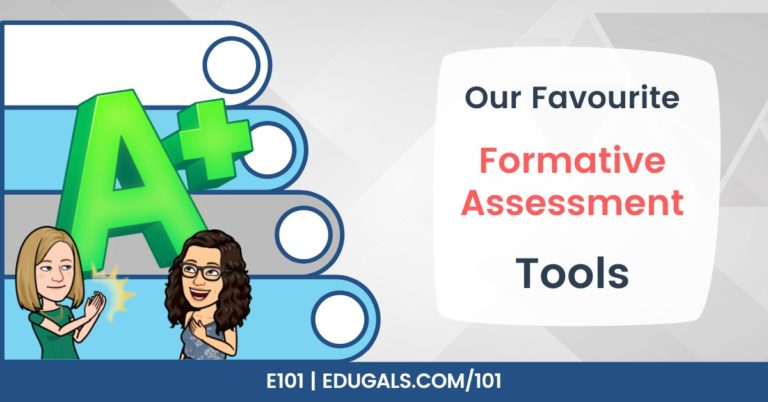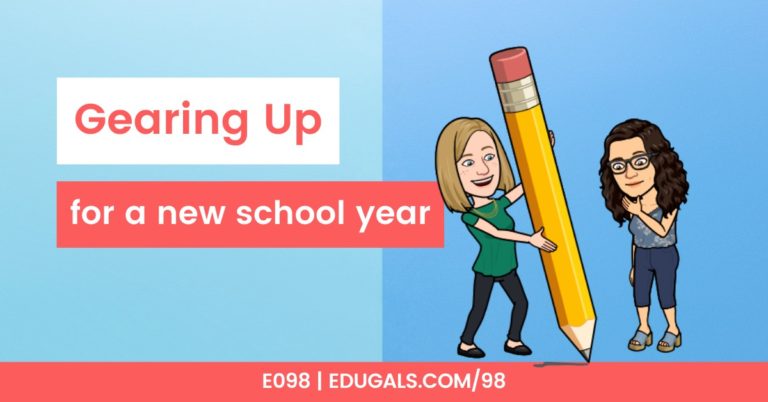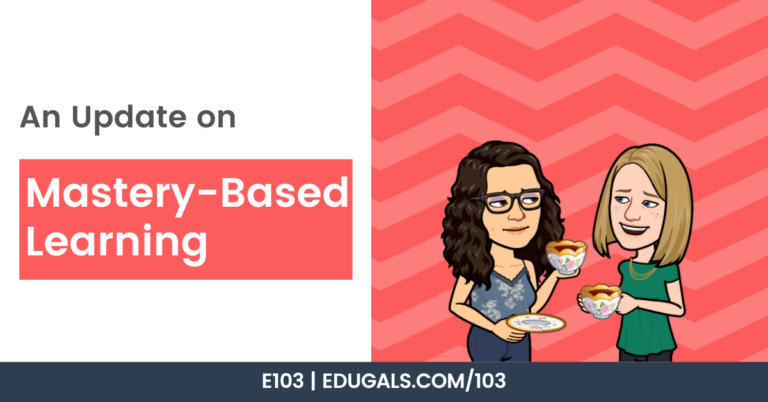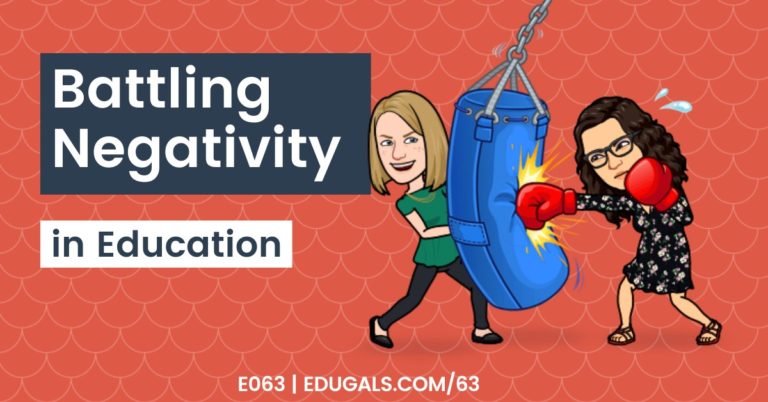In this episode, we are talking all about how to get ready for destreaming. As we are making a huge shift towards single stream (academic) or destreamed curriculum, we thought that we would share some strategies that you can use as you start to plan for next year!
If you like what you hear, then share this episode with a colleague or friend, and make sure you subscribe so that you don’t miss out on any new content! If you are able, consider supporting the show by buying us a coffee!
We would love to hear from you – leave a comment here, OR check out our FLIPGRID!
Show Notes
This week, we are diving into a conversation about destreaming. This topic is top of mind for most Ontario educators right now because the government recently announced that destreaming is coming in the fall. Grade 9 science will join math and become officially destreamed, while the remaining grade 9 courses will become single streamed with the academic stream only.
This is a big shift from how things have been done in Ontario, and with that shift brings a whole range of reactions and emotions.
Change is not easy; it is scary and can cause a range of reactions, including fear reactions. As such, it’s a good thing that the government chose to announce single stream and destreaming earlier this time around. It gives time for everyone to sit with the announcement, process it, and find ways to move forward.
In preparing for this week’s episode, we read Ontario 360’s Policy Paper on Destreaming, where we learned that Ontario is actually the only province that streams in Grade 9. Majority of the provinces begin streaming in Grade 10, with some subject areas even starting in Grade 11 in some provinces.

We found this really interesting! Grade 8 to Grade 9 is a big transition year. There is a lot of growing up and identity forming in that year, so this leap really isn’t the best time to select a stream. Grade 9 is totally different from elementary, and may actually end up as a better fit for some students that would typically be streaming into applied programming.
This movement of destreaming, and single streaming, allows students to complete a year in high school before having to make this pathway decision, which will have a big impact on possible career options and future opportunities.
It is certainly scary to consider how we are going to accommodate for all of the learners in our classroom. That being said, it is also an exciting opportunity to take a closer look at what we are teaching, and and to find some new ways or approaches to engage our students in our courses.
It’s also the perfect time to look at our curriculum in more detail to figure out what skills or expectations we have to cover – not based on what we have done in the past, but rather the specific expectations documented in the curriculum. From there, we can determine what we can change, how we can offer more choice, and pare back a bit as you are able!
This is a great approach for single stream courses, ie Academic programming only, however science will have a whole new curriculum, much like math did this year. It makes it really difficult to plan.
Last year, the destreamed math didn’t even get released until the end of June, so we are hoping for a more timely release for science. Math departments certainly worked hard this year to go with destreamed, to make the changes needed, and to do their best given the lack of government support and the current situation in education (covid and its impact on staffing, semester vs modified semester vs hybrid, absences due to illness, isolation rules, etc.).
Strategies and Tips for Destreaming
Now it’s time to share some strategies as we start single streaming and continue with destreaming in Ontario. Remember that there is no single way to accomplish this, so find strategies that work for you!
Go for done, not perfect!
Keep in mind: it may not go perfectly in year 1, and that’s okay! We need to try, learn from our mistakes, and make changes as we continue on. There are honestly some pretty great ideas out there.
It’s also important to recognize the reality of teacher burnout right now. Give yourself some grace and permission to make ends meet next year. It may not be pretty, and it may not be the best, but give yourself to breathe. You can continue to build as you continue to teach.
Reach out to Colleagues
There are so many options to consider here!
Math Colleagues
Math colleagues have already experienced destreaming, and they did it in one of the craziest years in Ontario education. Tap these amazing colleagues on the shoulder, ask them for advice, and see what worked for them!
What strategies did they try out? Were there approaches that worked better than others?
Elementary Educators
You could also consider reaching out to your elementary counterparts. It isn’t often that we have opportunities for cross panel conversations and sharing – education typically operates in the silos of elementary and secondary.
Elementary has always destreamed, and they typically use a different range of strategies and approaches, so take the time to reach out and see what has worked for them.
School Down the Street
Don’t forget about other schools in your Board! All schools are experiencing destreaming, so why not pair up with another school to share in the planning and course development?!
Collaboration is key in this situation, so take advantage of all of the resources around you.
Social media, particularly Twitter, is such a great resource for destreaming. So many educators have already started these conversations, as well as the planning. Check out key hashtags, such as #destreaming, as well as the specific course codes to locate conversations, resources and fellow educators that may be willing to collaborate and/or share.
Many educators from TDSB (Toronto District School Board) are also on Twitter, and may be willing to share resources and ideas. They have been doing destreaming for a little while now, and they had actual time to plan, versus trying to quickly plan during a pandemic. Many have publicly shared some resources and ideas already, so take a look on Twitter and see what you can find.
Give Teachers Options
It’s important that we jump back and consider how we are going to make meaningful changes while also addressing burnout.
It may be worth coming up with a menu of choices for course teams, and allowing teachers to choose from said menu, giving them that sense of autonomy and control that we all need, while also moving forward and using strong pedagogical changes needed for destreaming.
This could include mastery activities, and a Modern Classrooms Approach, but giving options for a range of teaching styles and preferences. For example, not everyone has to use instructional videos – you could provide options for still teaching live/in-person for those not yet ready to shift to videos. Then, everyone can still incorporate the must do, should do, and aspire to do activities.
This gives course teams the space they need as individual teachers, while moving towards destreaming and finding ways to effectively reach all students.
We don’t need to be step-in-step for all aspects of our courses, so we need to give each other space to figure out what destreaming means to each of us, and how it works practically in our classrooms. Though, assessment conversations should occur, because there should be some consistency in assessment practices.
It’s all about team work!
There are so many educators not ready, and likely feeling quite apprehensive about destreaming, but it’s important that we start having these conversations so that we can be more prepared for the next school year.
In areas where we are moving to Academic programming only, these conversations can actually be far more detailed. So get talking, focus on skills, and see how you can move forward.
Pedagogical Approaches to Consider
There are so many different approaches to consider as you begin to think about destreaming Grade 9 courses. Some of these approaches include the following:
- Modern Classrooms Project
- Mastery-Based Programming
- Ungrading
- Thinking Classrooms
- Universal Design for Learning (UDL)
- Where can I have different opportunities?
- Where can I insert choices for students?
- How can I allow students to demonstrate learning based on their individual strengths?
- Culturally Relevant and Responsive Pedagogy (CRRP)
- Station-based learning
- Design Thinking
All of these are great approaches for student learning. It isn’t possible to do them all, but consider taking some time learn about each of these approaches. From there, choose one that you think is the best fit for your curriculum area, for you, and for your students and try to implement this in at least part of your destreamed course.
It all comes down to what you are able to take on. Ask yourself: what are some little changes that I can take on in my classroom that really creates more accessibility for all of my students? It doesn’t have to be big or all-encompassing! It’s all about little steps that get us to our main goal.
Assessment Practices
We need to take a look at our current assessment practices and really examine how these practices support, or prevent, students from demonstrating their learning. There is very little “must do” in curriculum that relates to how a student demonstrates their learning, so we need to provide more options and opportunities for our students to be able to show us what they know.
If we want students to demonstrate their learning in writing, then we need to explicitly teach students how to do this in each of our curriculum areas. We cannot assume that other classes are teaching students how to write, and instead we need to build in scaffolds and supports to help students learn how to demonstrate their learning in this format.
We need to move away from traditional grades, and towards descriptive feedback. In the book Going Gradeless, Grades 6-12 by Elise Burns & David Frangiosa they talk about isolating key skills, developing a skill progression, and using the content as the vehicle to develop the skills.
There is so much power in removing the pressure of grades and getting students, and teachers, to focus on the development of skills and content knowledge to help students become successful.
Class Sizes
One of the big concerns in Ontario Education right now are class sizes, and the real motivation for destreaming in Ontario. We get it! We are also a little skeptical!
That being said, if we can use this as an opportunity to help more students to graduate from high school, to be able to choose to pursue college, apprenticeships, trades, university, work, etc. then it’s worth it!
When a student is earmarked as an applied student going into Grade 9 makes it so hard for students to dig themselves out of that should they wish to switch pathways. Research also shows that it’s also difficult for students labelled as applied to be successful and reach the College pathway.
Applied labels affect self esteem, and really limit what options students have for their future, plus it segregates these students and makes them feel like they are less than their “academic” peers.
Timing – Is it the right time for destreaming?
We recognize that this isn’t the best timing for such a significant change, but let’s be honest: there’s never a good time! If it wasn’t covid, it would be something else that is making it seem difficult or impossible.
We just need to embrace this, and do it to the best of our ability. It may take us 2-3 years to make it work the way we want it to, but that’s okay too! Just take the time – do what you can, and continue to adapt as you teach the course(s) again.
Resources
There are so many wonderful resources available to help make destreaming possible for educators. We thought we would share some of these resources here for you to check out, do some learning, and use as you see fit!
- Modern Classrooms Project
- Check out the free course – take small pieces as you see fit!
- Ungrading/Gradeless
- Station-based learning
- Edutopia
- Hacking Learning Centers In Grades 6-12 by Starr Sackstein & Karen Terwilliger
- Universal Design for Learning (UDL)
- Katie Novak, and her UDL resources
- Ontario Ed Policy – Learning For All
- Thinking Classrooms
- Peter Liljedahl – Building Thinking Classrooms
- Culturally Responsive and Relevant Pedagogy
- Design Thinking





